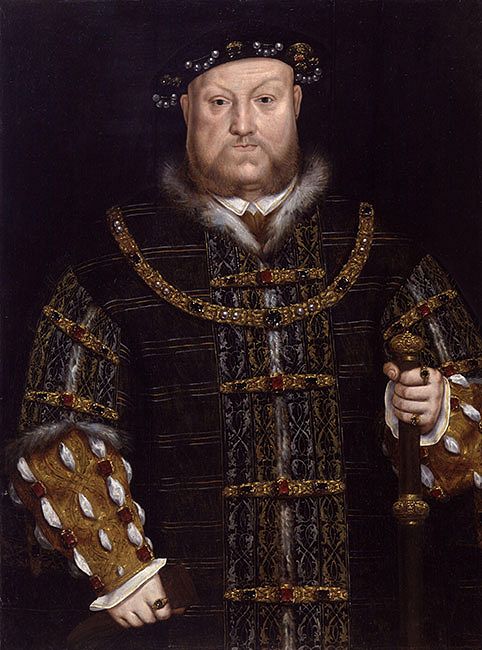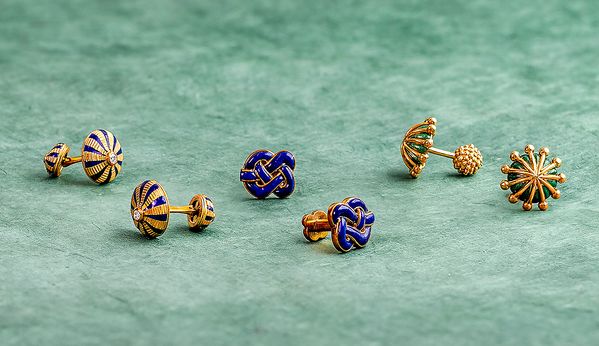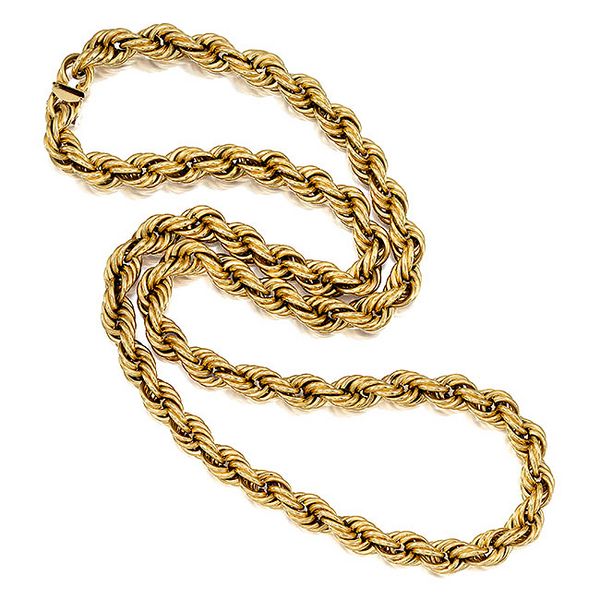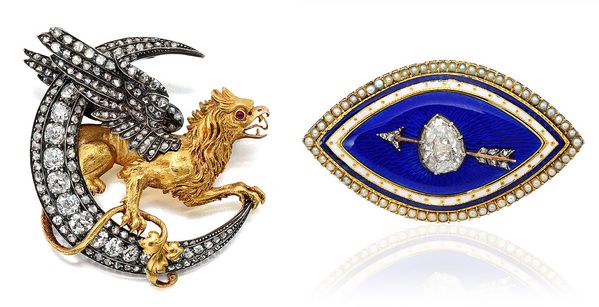In a nod to the men’s jewelry trend, Timothée Chalamet’s flaunts his Cartier de Panthère pendant with a shirtless ensemble at Oscars 2022. © Everett Collection Inc. / Alamy Stock Photo.
Written by Vivienne Becker
Historically, it was men who wore the jewels; the peacocks, flaunting their magnificence. It seems likely that the earliest jewels, made of animal teeth, claws, and shells were worn by hunter-gatherers as social signals, signs of prowess, or in the belief that the animal’s strength, cunning, or speed would be magically transferred to the wearer, or that a shell would invoke good will from otherworldly forces. As symbols of power and authority, or amuletic protection, jewels were attributes of kings, princes, emperors, nobles, tribal chiefs, and religious leaders. They were also emblems of personal identity, especially the signet ring, an evolution of the early cylinder seal used to stamp official documents.
During the Renaissance, men were magnificently bejeweled; their doublets embroidered with gold and silver thread, smothered with gems and pearls, hats adorned with badge-brooches. But the great female powerbrokers of the late Renaissance, Elizabeth I and Catherine de Medici, redressed the sartorial gender balance, covering their clothes, hair, and person with sumptuous jewels which served as part fashion, part propaganda proclaiming the supremacy of their realms. Since that time, men’s jewelry has seen peaks and troughs, from Regency fops through Edwardian dandies to 70s medallion man and the stacked bracelets of noughties businessmen. Jewels working in tandem with men’s fashion, and changing ideals of masculinity, as showcased in Fashioning Masculinities, the menswear exhibition at London’s Victoria & Albert Museum.

Installation view of Fashioning Masculinities. © Victoria and Albert Museum, London.
Today, the tide turns again. Men are fighting back against female domination in the jewelry stakes, fueled in part by gender fluidity, freedom of expression, and a general anti-establishment mission to break every jewel rule in the book. Today, more men are wearing more jewelry: brooches, earrings, necklaces, pearls, high jewelry creations, especially for formal, high-profile occasions. As men continue to push boundaries, we look back at a few key moments in the story of men in jewels.
Antiquity
The tomb of Tutankhamun was discovered in 1922 (100 years ago) buried with a spectacular stash of magnificent gold ornaments, many set with carnelian, turquoise and lapis lazuli, to soothe his path into the afterlife. Along with high-ranking Egyptian men, he wore plentiful gold jewels in life too: collars, earrings, signet rings. Greek gold jewelry, including wreaths for the head, was worn by men and women, while Roman and Etruscan youths wore a gold bulla – an amuletic pendant – to ward off evil spirits.
Middle Ages
Jewels played important and diverse roles in a hierarchical society, talismanic, heraldic, religious. Emperor Charlemagne’s famous talisman was a pendant reliquary set with sapphires. Men wore lavish hat jewels, elaborate cloak clasps, heavy gold chains, and orders of chivalry, like the Order of Golden Fleece, created and worn by the Duke of Burgundy, Philip the Good, known for the bejeweled splendor of his court.
Renaissance
Men’s ostentatious opulence reaches new heights; Henry VIII encouraged men to wear extravagant jewels: sleeves and doublets embellished with gems, pearls, gold and silver thread, heavier gold chains, elaborate hat badges, fistfuls of rings. Princes and noblemen of European courts were similarly bejeweled, especially the Medicis of Florence, patrons of artists and goldsmiths.

Henry VIII was infamous for amassing a spectacular collection of jewels.
Mughal India
Mughal Emperors were gem and jewel connoisseurs. They wore sumptuous diamond, spinel, or emerald-set ornaments from head to toe, sarpechs or turban ornaments, collars of wine-colored, tumbled spinels, carved emeralds from Colombia, and lustrous pearls from the Indian ocean and Arabian gulf. Jewels could be intricately enameled, with floral designs, evoking the gardens of Paradise.
17th Century and Versailles
King Charles I of Great Britain was never without his stupendous pearl earring, a fashion taken up by his courtiers, and the perfect accompaniment to luxurious lace collars and cuffs. While in Versailles, the Sun King, Louis XIV, dazzled in diamonds, wearing great suites of diamond buttons on fashionable long waistcoats and jackets, as well as buckles, rings and pins.

Until his death, portraits of King Charles I showed him wearing a single pearl in his left ear.
18th Century
Under the influence of Beau Brummell, the quintessential Regency dandy, men’s clothes became less ornate, moving away from courtly opulence towards tailored simplicity inspired by English country clothes. Jewels for men were subject to the same rationalization, worn primarily for practical purposes, such as a watch, a chain, cufflinks or shirt studs. The cravat however was of vital importance for any gentleman of fashion, and would be fixed with an exquisite gem-set stickpin.
Victorian Era
With his three-piece suit, the well-dressed 19th century gentleman wore a gold watch tucked into his pocket, attached to a dangling gold tassel, seal, or heavy gold chain draped across his waistcoat. He also wore a tie or stick pin, often with a novelty, animalier or sporting theme, cufflinks, and perhaps a signet ring.
Edwardian Era
The Edwardian or Belle Époque Proustian dandy was fixated on fashion, elegance, refinement, creating a sartorial playbook that included fine jewels: stickpins set with gems, such as the demantoid garnet, perfect pearl or ruby, ornate cufflinks, often enameled or lavishly gem-set, watches, and watch chains. Dress sets were worn with evening suits in simple black or white mother-of-pearl, diamond-studded or dazzlingly gem-set.

A selection of cufflinks offered in Phillips' Jewels & More: Online Auction. Photo Credit: Laura Randall.
Maharajahs
In the 1920s, the dashing, fabulously wealthy and jewel-bedecked Maharajahs travelled to London and Paris accompanied by chests overflowing with gems to be reset in the latest European fashions. They exerted an enduring influence on male sartorial trends through their innate style of jewel-wearing: row upon row of rare, precious natural pearls, gem-set turban ornaments, collars and armbands inset with carved emeralds. Patiala ordered the famous multi-strand necklace from Cartier, while the supremely elegant Maharajah of Indore switched seamlessly from traditional Indian dress, adorned with the historic pair of pear-shaped Golconda diamonds, the Indore Pears, to the latest sleek Paris white tie fashions, accessorized with this much-loved ruby ring and Art Deco gemset cufflinks.
1960s-70s
The swinging decades of social and cultural revolution ushered in a massive resurgence of men’s jewelry, on the crest of the unisex wave and from jet-set travels: the identity bracelet, gold chains, medallions, dog tag pendants, elephant hair bracelets. Keith Richards kickstarted a trend with his silver sculptural skull ring, and rock stars become the new jewel patrons.

Phillips' Jewels & More: Online Auction offers a wide selection of classic gold chains, to be worn by women or men.
Noughties
Barriers break down with questions around gender ambiguity, and men including city types and CEOs instigated dress-down Fridays, and wore stacks of bracelets, and neckchains inside shirt collars.
This new wave of men in jewels has been gathering momentum, fueled by a surge of creativity in menswear design and gender fluidity, but also by hip-hop artists and their uninhibited embrace of bling. It started with brooches, worn with daring panache on tuxedo jackets, on red carpets. While Elton John has long been a fan of brooches, it was Pharrell Williams who really lit the spark, wearing in 2017 a Chanel diamond camelia brooch, teamed with a long, layered necklace from the fashion jewelry collection.

Pharrell Williams turned heads by sporting a Chanel brooch on the Red Carpet. © UPI / Alamy Stock Photo.
More men began to realize the power of the brooch to express personal style, liven up a tailored jacket, and grab the limelight at the same time. Timothée Chalamet wears Cartier brooches, both vintage and contemporary, and the late Chadwick Boseman loaded his lapel with three Tiffany diamond leafy creations. Male celebrities began to add more jewels, especially necklaces: classic gold chains, diamond rivieres, emeralds, a Grima collar worn by Marc Jacobs, or Chalamet’s Cartier Panthère pendant.

The brooch trend continues. Left: A French diamond ruby, gold, and silver-topped gold "Griffin and Crescent" brooch offered in our Jewels New York sale. Right: A Georgian Diamond, Pearl, Enamel, Silver and Gold Brooch offered in our Jewels & More: Online Auction.
But the biggest and most subversive trend has been pearls for men; both the single pearl earring – very Charles I – seen on Harry Styles, and necklaces, as worn by A$AP Rocky, Elton John, and Billy Porter. Mikimoto, known for its pearls and classicism, collaborated with Comme des Garçons for an edgy men’s collection and chose Song Wei Long as a male global ambassador for their latest Passionoir collection of black pearl jewelry, clearly targeted at men. The classic pearl strand, once an emblem of timeless femininity, signals the start of a new age of princely magnificence.

A classic pearl necklace offered in our Jewels & More: Online Auction.
Recommended Reading
